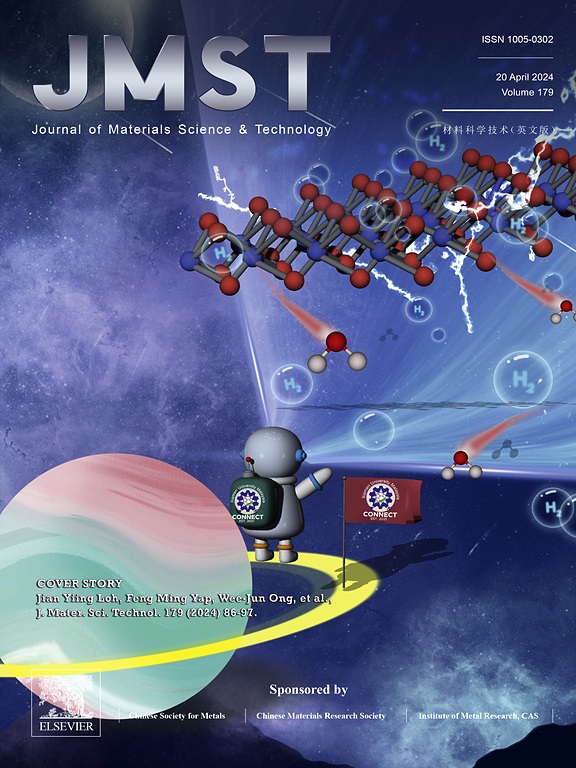Biological skin-inspired damage warning and self-healing thermoelectric aerogel fiber via coaxial wet spinning for wearable temperature sensing
IF 14.3
1区 材料科学
Q1 MATERIALS SCIENCE, MULTIDISCIPLINARY
引用次数: 0
Abstract
Biopolymer-based temperature-sensing fibers are increasingly employed to realize the eco-friendly concept of wearable electronics. However, keeping their long-term development remains challenging due to limited mechanical robustness and poor environmental tolerance. Herein, a bionic autonomous self-healing thermoelectric (TE) aerogel fiber with visual damage warning function (STDF) inspired by biological skin was prepared via a coaxial wet spinning strategy, which yielded a core-shell heterogeneous structure with a protective sheath with an intrinsic self-healing ability and a temperature-sensing core layer. The core layer of STDF, composed of flexible thermoplastic polyurethane embedded with rigid Ti3C2Tx MXene, effectively minimizes disruptions in continuous conductive pathways during repeated extreme bending. Featuring a synergistic network of reversible hydrogen bonds and dynamic Schiff-base linkages constructed among oxidized alginate, sericin, and tannic acid, the fractured STDF aerogel fiber exhibits exceptional water-responsive self-healing efficiency (97.51% stress recovery). Moreover, the visual damage location in STDF fiber is enabled through a coloration reaction at the damaged interface between the Fe2+ ions and 1,10-phenanthroline incorporated into the core and sheath layers, respectively. Furthermore, the resultant STDF demonstrates a wide-range temperature-sensing performance at 100–500°C and an ultrasensitive alarm response time (within 2 s) when encountering fires. This work sheds new light on the design of bionic temperature sensing fibers with environment-adaptive self-healing and damage warning abilities for improved reliability and durability in real-world wearable application scenarios.

生物皮肤损伤预警及自修复热电气凝胶纤维同轴湿纺可穿戴式温度传感
基于生物聚合物的温度传感纤维越来越多地被用于实现可穿戴电子产品的环保概念。然而,由于有限的机械稳健性和较差的环境耐受性,保持其长期发展仍然具有挑战性。本文以生物皮肤为灵感,采用同轴湿纺丝策略制备了具有视觉损伤预警功能的仿生自主自愈热电(TE)气凝胶纤维,该纤维具有具有自愈能力的保护鞘和温度传感核心层的核-壳非均质结构。STDF的核心层由嵌入刚性Ti3C2Tx MXene的柔性热塑性聚氨酯组成,可以有效地减少反复极端弯曲时连续导电路径的中断。由于氧化海藻酸盐、丝胶蛋白和单宁酸之间形成了可逆氢键和动态希夫碱键的协同网络,断裂的STDF气凝胶纤维表现出优异的水响应自修复效率(97.51%的应力恢复)。此外,STDF纤维中的视觉损伤位置是通过Fe2+离子与掺入芯层和鞘层的1,10-菲罗啉在受损界面上的显色反应实现的。此外,所得的STDF在100-500°C范围内具有广泛的温度传感性能,并且在遇到火灾时具有超灵敏的报警响应时间(在2秒内)。这项工作为设计具有环境自适应自修复和损伤预警能力的仿生温度传感纤维提供了新的思路,从而提高了实际可穿戴应用场景中的可靠性和耐久性。
本文章由计算机程序翻译,如有差异,请以英文原文为准。
求助全文
约1分钟内获得全文
求助全文
来源期刊

Journal of Materials Science & Technology
工程技术-材料科学:综合
CiteScore
20.00
自引率
11.00%
发文量
995
审稿时长
13 days
期刊介绍:
Journal of Materials Science & Technology strives to promote global collaboration in the field of materials science and technology. It primarily publishes original research papers, invited review articles, letters, research notes, and summaries of scientific achievements. The journal covers a wide range of materials science and technology topics, including metallic materials, inorganic nonmetallic materials, and composite materials.
 求助内容:
求助内容: 应助结果提醒方式:
应助结果提醒方式:


